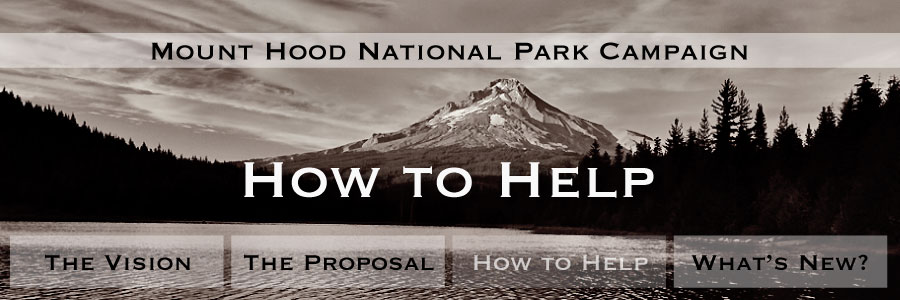|
Q
|
What's the difference between a National Park and a National Forest? |
|
A
|
A National Park is created for the express purpose of preserving an area of special natural or historical significance for all time. The core mission of the National Park Service is to protect this national legacy for generations to come.
A National Forest is managed under the U.S. Department of Agriculture as a place where recreation, grazing, timber production, mining and wildlife must coexist under a multiple use philosophy. The core mission is to allocate the consumption of these resources.
|
|
Q
|
If Mount Hood becomes a National Park, what would the most obvious changes be? |
|
A
|
There are a trio of recreational uses that are generally not allowed (with notable exceptions) in national parks: hunting, mountain biking and snowmobiling -- though new rules allowing park managers to more easily accommodate mountain bikes are in the works. Commercial logging, grazing and mining would also prohibited, with the exception of tree thinning needed to restore formerly logged areas. Commercial ventures, such as lodges and ski areas, could remain but would expand under more rigorous guidelines.
In the long term, much of the logging road network surrounding Mount Hood would be vacated under national park management, since the emphasis would be on restoring natural habitat and landscapes. A number of these old routes would be converted to bike or walk trails under the Mount Hood National Park proposal.
|
|
Q
|
Would the entire Mount Hood National Forest become a National Park? |
|
A
|
No, the proposal calls for a Mount Hood National Park and Preserve for the northern part of the current national forest, but a Clackamas National Recreation Area would cover much of the southern part of the forest. This southern portion of the forest has been heavily roaded and logged, and does not contain the degree of natural spectacle found at Mount Hood proper and in the Columbia Gorge. A map of the proposal can be found here.
A much larger portion of the Columbia River Gorge is already designated as a National Scenic Area. The main drawback of this designation is that the Forest Service continues to be the steward for the scenic area. This proposal would withdraw the area on the Oregon side from the Sandy River to Hood River to become part of the new Mount Hood National Park, leaving the rest of the scenic area under existing management.
|
|
Q
|
What's so bad about the Forest Service? |
|
A
|
Nothing, if you want to see Mount Hood managed as it has been for the past several decades. This is not because Forest Service employees are bad - quite the contrary, they face some of the toughest resource management challenges - but because this federal agency's mission is fundamentally conflicted. The Forest Service is forever paralyzed by the competing demands of recreation, commercial development and resource extraction pressures, and is ill-suited to take on the role of steward of a national treasure like Mount Hood. |
|
Q
|
Would a national park designation bring more recreation dollars to Mount Hood? |
|
A
|
Absolutely. Even during the Bush administration, which was hostile to most environmental concerns, funding for National Parks increased while National Forest funding continued to decline. As the comparison chart at the top of this page shows, National Parks not only have better funding, but also have a fraction of the road system to maintain, allowing more funding to focus on recreation and environmental stewardship. Most National Parks also charge entry fees, and this would also bring more funding to Mount Hood for recreation improvements and park management. |
|
Q
|
What would happen to the wilderness areas that already existing around Mount Hood? |
|
A
|
They would continue to exist under national park status, with no changes to wilderness boundaries. At least four - the Columbia, Mount Hood, Salmon-Huckleberry and Badger Creek - would likely fall inside a national park boundary for Mount Hood, as well as many of the additions in the Lewis and Clark wilderness legislation. |
|
Q
|
Won't a national park designation simply bring more crowds to Mount Hood? |
|
A
|
Yes and no. It's clearly true that more people would likely seek Mount Hood as a tourist destination, since national parks in America draw visitors from around the globe. But serving more people doesn't have to mean crowding. There are plenty of opportunities for expanding the number of recreational opportunities to meet the demand, while also protecting other areas in the park from tourism entirely. The Mount Hood National Park proposal outlines many of these new facilities.
One difference in tourism is that national parks draws more distant visitors who are likely to spend multiple days in the area, patronizing local lodging and services.
|
|
Q
|
Does the existence of US 26 and I-84 as national highway routes preclude a national park designation for Mount Hood and the Gorge? |
|
A
|
No. There are many examples of federal highways that cross national parks. But you could expect these routes to be managed differently, with a better design aesthetic that respects the natural surroundings, and more attention paid to the negative effects of highway noise and storm runoff. |
|
Q
|
What would happen to the private land inholdings at Government Camp and along the Hoodland corridor? |
|
A
|
The Hoodland area would remain outside park jurisdiction of any kind, given the degree to which this area has been developed. Likewise, Government Camp would remain as a private inholding, but would clearly benefit from National Park Service investments in the area that could help the continued recovery of the village as a tourism destination.
Undeveloped inholdings (mostly a few private timber tracts) would be viewed in the same way as they are now under Forest Service management. The private timber holdings along the West Fork hood River would also be targeted for public acquisition. The federal agencies would continue to work toward land trades or purchases to bring these private parcels into federal ownership. A national park designation might have the effect of accelerating this process, assuming more funding for acquisition than is available under Forest Service administration.
|
|
Q
|
What would happen to the lodges that already exist in the forest? |
|
A
|
Many visitors to Crown Point, Multnomah Falls and Timberline Lodge are already confused by the presence of these "national park-like" structures. Indeed, they would give Mount Hood an instant historic legacy as a national park, and a park designation would help direct future funding to ongoing maintenance of these treasures. The Mount Hood National Park proposal also includes concepts for new lodges at points throughout the park, complementing the existing facilities. |
|
Q
|
How would the ski areas be affected by a national park designation? |
|
A
|
All five ski areas on Mount Hood operate on public land, through permits from the Forest Service. Thus, the National Park Service would become the new manager of these permits. In the past, the most controversial expansion plans have involved ski lifts extending to sensitive areas above timberline or requiring large areas to be cleared for ski runs. It's likely that the Park Service would frown on further expansion of this kind, while ensuring that the operators maintain their current facilities in more environmentally responsible way.
The Timberline operators would almost certainly be required to groom the Palmer Glacier more discretely, avoiding the giant "corn field" square that is visible from miles around. They would likely be required to discontinue the environmentally dubious practice of softening the glacier with rock salt for summer skiers. The Meadows operators would likely be asked to improve their buildings and parking area to be less shabby, and allow for summer visitors to use the lodge. Ski runs in both areas would be managed until a truly natural appearance resulted - a goal espoused by operators, but rarely achieved.
|
|
Q
|
How would the wilderness and backcountry area be managed differently by the Park Service? |
|
A
|
For starters, building and maintaining trails would be a priority. There are so many opportunities for new trails to spread out the hiking demand around Mount Hood, but the Forest Service has added almost none since the 1970s. The Park Service would likely be more restrictive on backcountry camping sites along heavily-used trails, such as the Timberline Trail. A good example is the Wonderland Trail around Mount Rainier, which has strictly enforced camping areas. This is an illustration of the Park Service would ultimately put the preservation of the park, itself, ahead of all human uses.
However, part of the mission for a new Mount Hood National Park would be a combination of expanded recreation opportunities, as well as restoration of damaged landscapes. For this reason, a new park at Mount Hood would be different from existing parks, and not easily compared to places that were never developed to begin with, like Mount Rainier.
|
|
Q
|
What's would it take for Mount Hood to become a National Park? |
|
A
|
A bill in Congress with support from most or all of the Oregon delegation and a President willing to sign it. It could happen in a year, ten years or never, depending on whether one of our representatives in Washington D.C. decides to champion the idea. |





